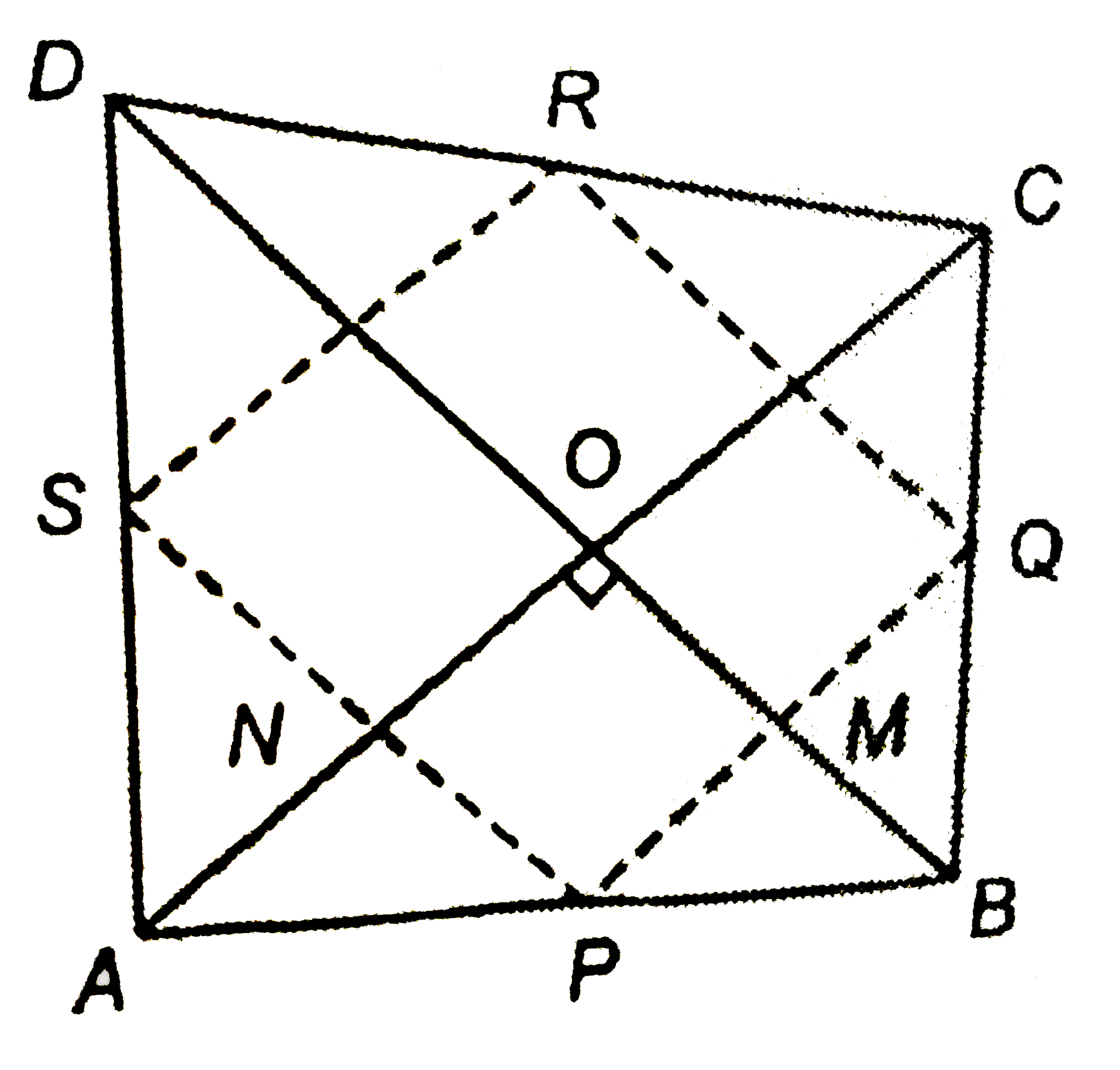Show that the quadrilateral formed by joining the mid-points of the consecutive sides of a rectangle is a rhombus.
To show that the quadrilateral formed by joining the midpoints of the consecutive sides of a rectangle is a rhombus, we will follow these steps:
Step 1: Define the Rectangle and its Midpoints
Let the rectangle be ABCD where:
- A(0,0)
- B(a,0)
- C(a,b)
- D(0,b)
The midpoints of the sides are:
- P (midpoint of AB): P(0+a2,0+02)=P(a2,0)
- Q (midpoint of BC): Q(a+a2,0+b2)=Q(a,b2)
- R (midpoint of CD): R(a+02,b+b2)=R(a2,b)
- S (midpoint of DA): S(0+02,b+02)=S(0,b2)
Step 2: Determine the Lengths of the Sides
Now, we will find the lengths of the sides of quadrilateral PQRS.
1. Length of PQ:
PQ=√(a−a2)2+(b2−0)2=√(a2)2+(b2)2=12√a2+b2
2. Length of QR:
QR=√(a2−a)2+(b−b2)2=√(−a2)2+(b2)2=12√a2+b2
3. Length of RS:
RS=√(0−a2)2+(b2−b)2=√(−a2)2+(−b2)2=12√a2+b2
4. Length of SP:
SP=√(a2−0)2+(0−b2)2=√(a2)2+(−b2)2=12√a2+b2
Step 3: Show that All Sides are Equal
From the calculations above, we have:
PQ=QR=RS=SP=12√a2+b2
Since all four sides of quadrilateral PQRS are equal, we can conclude that PQRS is a rhombus.
Conclusion
Thus, we have shown that the quadrilateral formed by joining the midpoints of the consecutive sides of a rectangle is a rhombus.
---
Let the rectangle be ABCD where:
- A(0,0)
- B(a,0)
- C(a,b)
- D(0,b)
- P (midpoint of AB): P(0+a2,0+02)=P(a2,0)
- Q (midpoint of BC): Q(a+a2,0+b2)=Q(a,b2)
- R (midpoint of CD): R(a+02,b+b2)=R(a2,b)
- S (midpoint of DA): S(0+02,b+02)=S(0,b2)
Now, we will find the lengths of the sides of quadrilateral PQRS.
PQ=√(a−a2)2+(b2−0)2=√(a2)2+(b2)2=12√a2+b2
QR=√(a2−a)2+(b−b2)2=√(−a2)2+(b2)2=12√a2+b2
RS=√(0−a2)2+(b2−b)2=√(−a2)2+(−b2)2=12√a2+b2
SP=√(a2−0)2+(0−b2)2=√(a2)2+(−b2)2=12√a2+b2
From the calculations above, we have:
PQ=QR=RS=SP=12√a2+b2
Since all four sides of quadrilateral PQRS are equal, we can conclude that PQRS is a rhombus.
Thus, we have shown that the quadrilateral formed by joining the midpoints of the consecutive sides of a rectangle is a rhombus.
Topper's Solved these Questions
Similar Questions
Show that the quadrilateral formed by joining the mid-points of the consecutive sides of a rectangle is a rhombus.
View SolutionShow that the quadrialteral formed by joining the mid-points of the consecutive sides of a rhombus, is a rectangle.
View SolutionThe diagonals of a quadrilateral ABCD are mutually perpendicular . Prove that the quadrilateral formed by joining the mid-points of its consecutive sides is a reactangle.
 View Solution
View SolutionProve that the quadrilateral formed by joining the mid-points of the pairs of consecutive sides of a quadrilateral is a parallelogram.
View SolutionThe diagonals of a quadrilateral ABCD are perpendicular. Show that the quadrilateral, formed by joining the mid-points of its sides, is a rectangle.
View SolutionShow that the quadrilateral, formed by joining the mid-points of the sides of a square, is also a square.
View SolutionShow that the quadrilateral, formed by joining the mid-points of the sides of a square is also a square.
View SolutionProve that the figure formed by joining the mid-points of the pairs of consecutive sides of a quadrilateral is a parallelogram.
 View Solution
View SolutionProve that the figure formed by joining the mid-points of the pair of consecutive sides of a quadrilateral is a parallelogram. OR BACD is a parallelogram in which P,Q,R and S are mid-points of the sides AB,BC,CD and DA respectively. AC is a diagonal. Show that : PQ∣∣AC and PQ=12AC SR∣∣AC and SR=12AC PQ=SR (iv) PQRS is a parallelogram.
View SolutionProve using vectors: The quadrilateral obtained by joining mid points of adjacent sides of a rectangle is a rhombus.
View Solution

